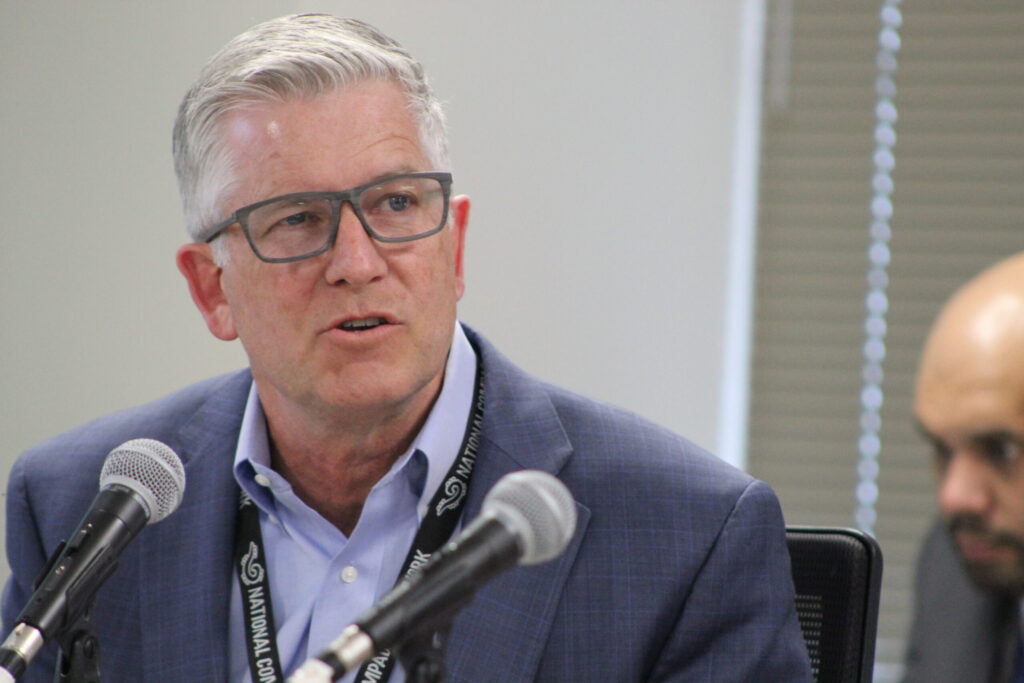Where technology meets the plate | GABEL

Rachel Gabel
Colorado State University opened the doors of its first experiment station since 1996. More than 100 guests were in attendance at CSU Spur for a presentation and tour of the Metropolitan Agricultural Research Center, or MARC. Land grant universities are tasked with looking far ahead and solving agricultural challenges, and that is what CSU is doing.
The MARC will focus on urban agriculture, organic growing methods and harnessing the latest agricultural technology. During the grand opening, attendees were able to taste test strawberries, participate in a pickling workshop and tour greenhouses, agrivoltaics installations and other controlled-environment agriculture research facilities.
Most of the state’s other nine research centers concentrate on various segments of Colorado agriculture. The Colorado Agricultural Experiment Station, or CAES, was established by the Hatch Act in 1887 to create research centers in connection with the land grant universities to conduct research in unique regional environments to address agriculture challenges.
Stay up to speed: Sign up for daily opinion in your inbox Monday-Friday
At ARDEC in Fort Collins, research focuses on diverse crop and livestock systems, plant breeding and seed increase. In Rocky Ford, research concentrates on vegetable crop development and systems and water use; in Akron, research centers on beef production, breeding and grazing management. In Walsh, research concentrates on dryland and limited irrigation cropping systems; in Center, research focuses on potato breeding, storage and production; in Yellow Jacket, research centers on dryland and irrigated crops, soil health, and alternative crops. In Orchard Mesa, tree fruit and vine research is conducted; in Fruita, water efficient cropping systems are central research topics, and in Hotchkiss, tree fruit and vines and cover crop research is conducted.
It’s interesting, but it doesn’t necessarily draw a crowd and engage them as they learn.
Conversely, Eugene Kelly, the director of the Agricultural Experiment Station, said there are school buses lined up every day at the CSU Spur Campus, bringing students and adults to campus to see agriculture up close in the middle of Denver. Kelly said 85% of people in Colorado live in urban and suburban areas so it is a unique opportunity to study agriculture where most people live. The food production systems in urban ecosystems are obviously different than the ecosystems where dryland wheat and feedyard cattle production is studied, and therein lies its value. With 85% of voters living removed from production agriculture, it’s important they support the industry. The consequences of the alternative are playing out in the state and national stages now.
The center boasts greenhouses, hydroponics, growth chambers, community gardens and are all driven by technology changes. There is also a food innovation center that can develop new pickling technologies or even a new type of potato pancake. It is literally where technology meets the plate.
Kelly, who spent much of his career abroad, said the technology studied can translate into other production systems and allows an understudied ecosystem to be accessible to people interested in food. The staff at the station are also diverse in their backgrounds.
While working in South Africa, he said he would drive out of Johannesburg and see people walking from the city to the rural areas to work in agricultural production. Kelly said he wondered then why food couldn’t be grown where people live. Obviously, there are limits to the space available, and it is unlikely to feed the world on a huge scale. However, there is value in children getting their hands dirty and value in tasting a fresh strawberry you had a hand in growing, and dignity in growing food and providing for families. It is, Kelly said, cultivating resilience in cities.
Kelly commented at the ceremony that agriculture is humanity’s largest industry. Not only does everyone eat, that food has to be grown, harvested, shipped, sold, prepared and the like, touching everyone’s lives in multiple ways. Investing in food, investing in people’s understanding and appreciation of the industry that feeds them, and making agriculture accessible to the 85% in cities is money well spent.
Rachel Gabel writes about agriculture and rural issues. She is assistant editor of The Fence Post Magazine, the region’s preeminent agriculture publication. Gabel is a daughter of the state’s oil and gas industry and a member of one of the state’s 12,000 cattle-raising families, and she has authored children’s books used in hundreds of classrooms to teach students about agriculture.










